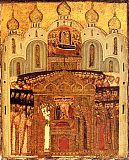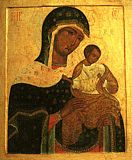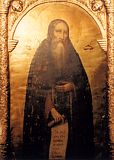

| Previous day | Next day |
| Old Style
July 10
|
Tuesday |
New Style
July 23
|
| 6th Week after Pentecost. Tone 4. | No fast.
|
![]() The Placing of the Precious Robe of the Lord at Moscow (1625) (1625).
The Placing of the Precious Robe of the Lord at Moscow (1625) (1625). ![]() Holy 45 Martyrs at Nicopolis in Armenia, including Leontius, Maurice, Daniel, Anthony, Alexander, Anicetus, Sisinius, Meneus, Verelad, and Timothy (ca. 319).
Holy 45 Martyrs at Nicopolis in Armenia, including Leontius, Maurice, Daniel, Anthony, Alexander, Anicetus, Sisinius, Meneus, Verelad, and Timothy (ca. 319). ![]() St. Anthony of the Kiev Caves, founder of monasticism in Russia (1073).
St. Anthony of the Kiev Caves, founder of monasticism in Russia (1073).
Martyr Apollonius of Sardis (3rd c.). Martyrs Bianor and Silvanus, of Pisidia (4th c.). 10,000 Fathers of the desert and caves of Scetis martyred by the impious Patriarch Theophilus of Alexandria (ca. 398). St. Silouan of the Far Caves in Kiev (13th c.-14th c.). Sts. Eumenius (1920) and Parthenius (1905), restorers of Koudouma Monastery on Crete.
New Hieromartyr Basil Pobedonostsev, archpriest, of Kamensky Zavod (Perm) (1918).
“Konevits” Icon of the Most Holy Theotokos.
New Hieromartyr Joseph, archpriest, of Damascus, and companions (1860). Synaxis of the Saints of Vatopedi, Mt. Athos. St. Gregory, bishop of Assos, near Ephesus (1150).
Thoughts for Each Day of the Year
According to the Daily Church Readings from the Word of God
By St. Theophan the Recluse

Tuesday. [I Cor. 1:1-9; Matt. 13:24-30]
The good seed was sown, but the enemy came and sowed tares among the wheat. The tares in the Church are heresies and schisms, and in each of us they are bad thoughts, feelings, desires, and passions. A person accepts the good seed of the word of God, decides to live in a holy way, and begins to live in this way. When such a person falls asleep, that is, when his attention toward himself weakens, then the enemy of salvation comes and places evil ideas in him, which if not rejected at the start ripen into desires and dispositions, introducing their own spheres of activity, which mix themselves in with good deeds, feelings and thoughts. Both remain together this way until the harvest. This harvest is repentance. The Lord sends the angels—a feeling of contrition and the fear of God, and they come in like a sickle, then burn up all the tares in a fire of painful self-condemnation. Pure wheat remains in the grain-house of the heart, to the joy of the man, the angels, and the most Good God worshipped in the Trinity.
Articles
 45 Holy Martyrs at Nicopolis in ArmeniaThe Forty-five Martyrs of the Armenian City of Nicopolis suffered during the reign of the emperor Licinius (311-324). |
 Martyr Apollonius of SardisThe Holy Martyr Apollonius came from the city of Sardis, located in Lydia (Asia Minor). |
 Icon of the Mother of God of KonevitsThe holy icon was glorified by many miracles. |



